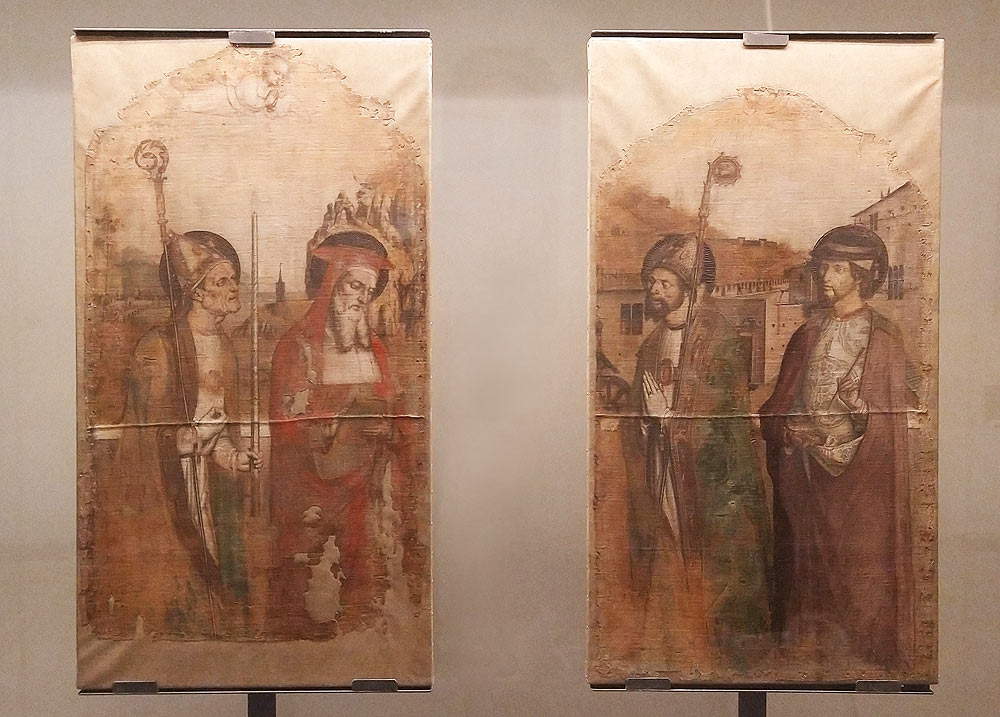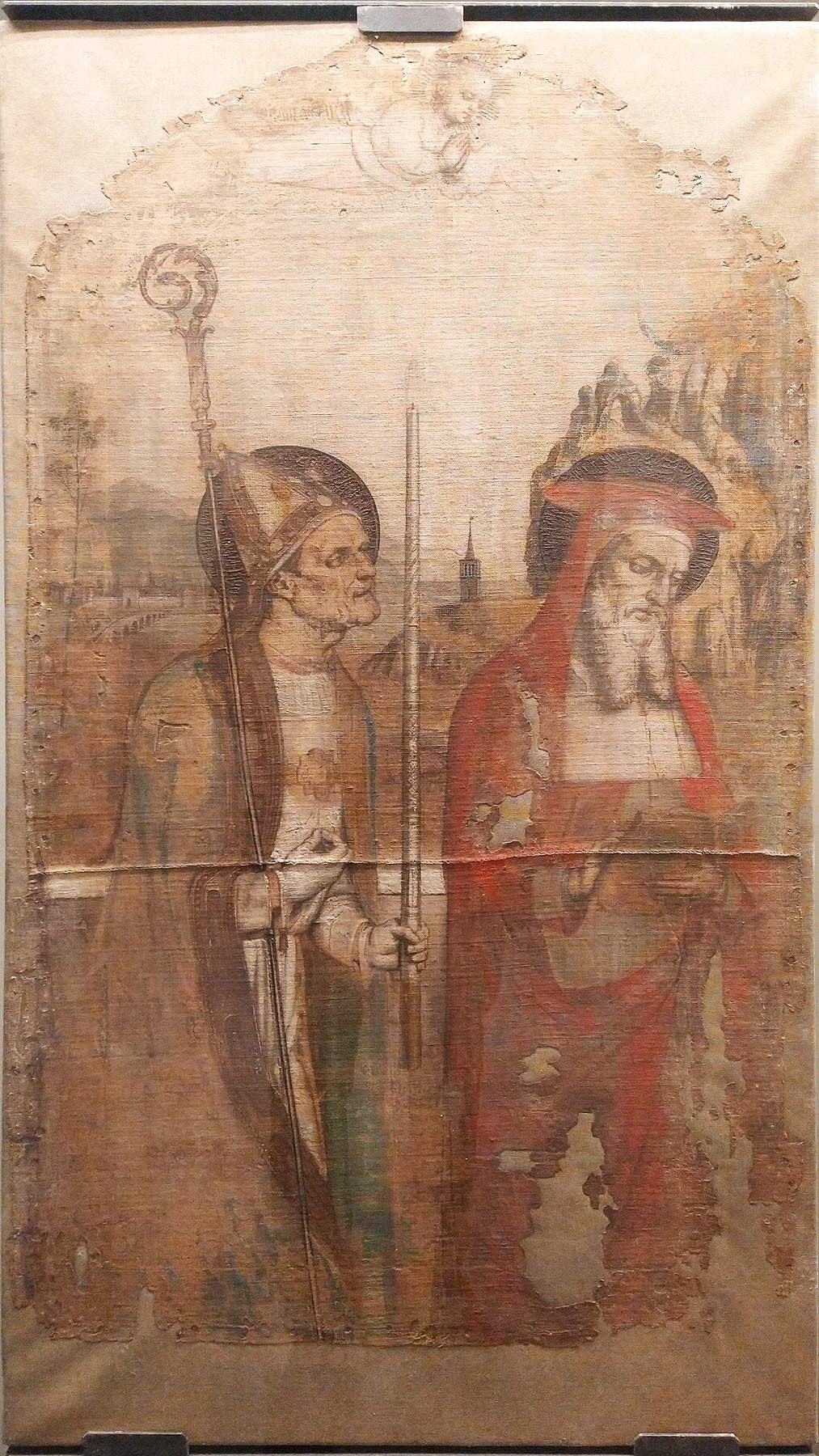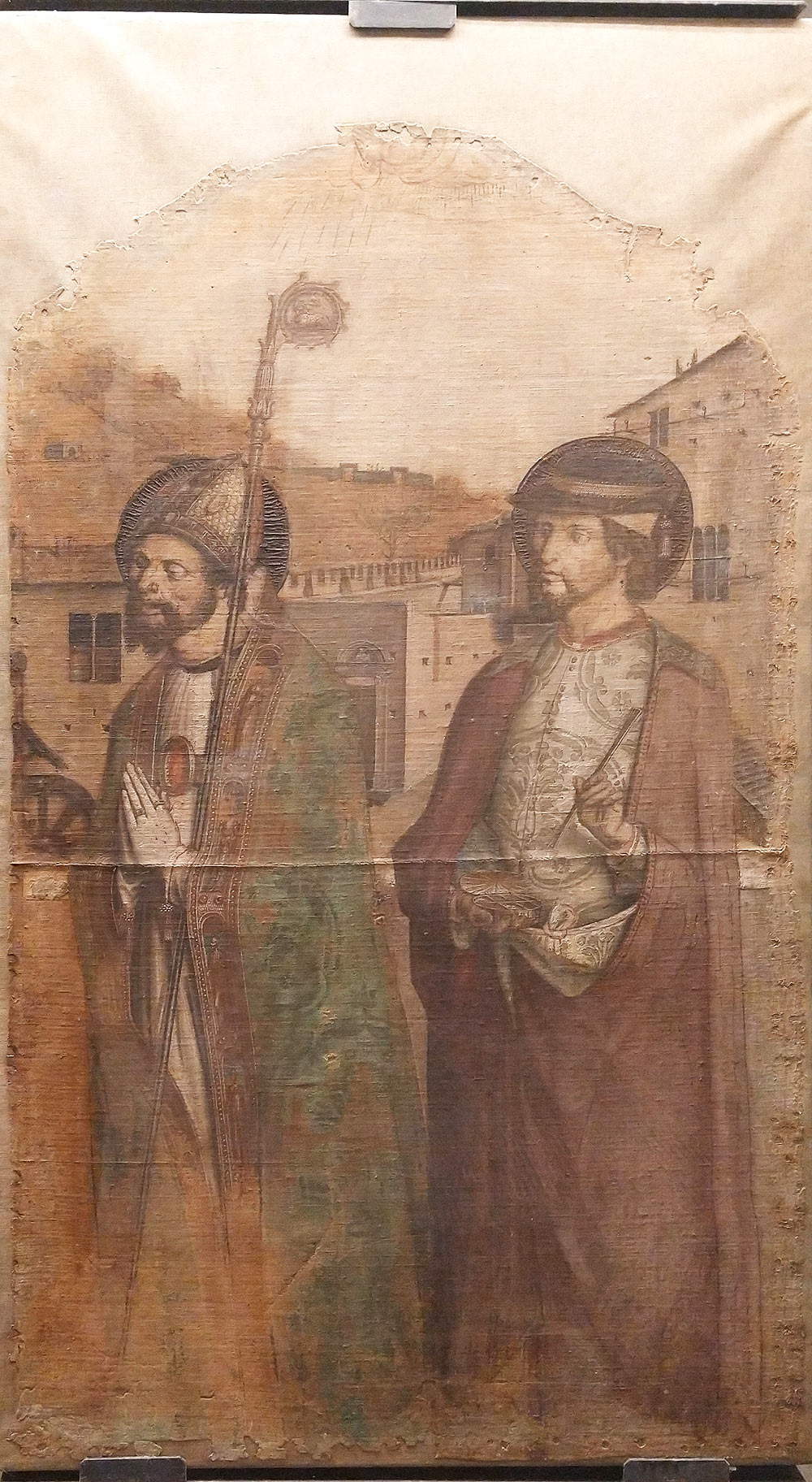In the small and surprising Diocesan Museum of La Spezia, in what was once the nave of the ancient oratory of San Bernardino and is now the central room of the collection, a large glass case holds two fragments of canvas: they are wispy, faded and in pieces, but the ravages of time have not affected the strength that these two images manage to emanate. They are remnants of a larger work, which were returned in the 1950s to a great Lombard painter who was very active in Liguria: Carlo Braccesco. An artist whose rediscovery is a relatively recent fact: it was in 1911 when the restoration of the Montegrazie polyptych, directed by Alessandro Baudi di Vesme, led to the discovery of the signature “Carolus Mediolanensis,” allowing the reconstruction of the itinerary of an author who until then was known only from the papers discovered some forty years earlier by Federico Alizeri. For Roberto Longhi, who devoted various attentions to Braccesco, the Milanese painter was “the king of gold of the Lombard Quattrocento,” an artist “dignus intrare nell’empireo già so well stowed with the genius of Italian painting,” “the only Lombard painter who, even expatriate, had such weight as to transmit his fame as far as the culture of the late sixteenth century Milanese.”
The first saint in the fragment on the left is Saint Erasmus, identified by his bishop’s vestments and the candle he holds in his hand, an allusion to his role as patron saint of sailors: in ancient times it was believed that the fire of Saint Elmo (another name for Saint Erasmus), that peculiar electrical phenomenon that occurs on the masts of ships just before storms, was a sign of his presence. Next to him appears Saint Jerome, wearing the typical cardinal’s robe. The fragment on the right, on the other hand, features a bishop saint who is difficult to identify (in the past it has been proposed to read the figure of St. Gotthard) and St. Pantaleo, recognizable by the doctor’s cassette he holds in his hand and which alludes to his profession. Instead, two angels loom at the top, and behind the figures is an urban landscape, much ruined, even more so than the figures.
Yet despite their precarious state, these wasted canvases still manage to release an energy that seizes anyone who sees them at the Museum, and that leaves no doubt of their status as among the most interesting works of the Ligurian Renaissance. Carlo Braccesco’s saints are strongly characterized, with a subtlety of a fine physiognomist: the relative lingers at length on the deep wrinkles of Saint Erasmus, on the grave and absorbed expression of Saint Jerome, on the lived and marked face of the holy bishop, on the sharp profile of Saint Pantaleo. Such individuated physiognomies were typical features of Lombard Renaissance painting. Also meticulous is the care with which Carlo Braccesco restores the beards and hairstyles of the saints (admire the curls of the bishop saint’s beard hairs, and those along the jawbone that have escaped precise shaving) and their vestments: the fine brocade jacket of Saint Pantaleo is one of the work’s highest pieces. Gustavo Frizzoni, to whom we owe the earliest known attestation of the two fragments (and which slightly precedes Alfredo d’Andrade’s drawings, preserved in Turin, where some details are reproduced), while wrongly considering them works “of mediocre character,” described them as “of a taste between Italian and Flemish.” Everything takes place against the backdrop of a city of the time: it is difficult to recognize the buildings, but when one enters the two fragments by Carlo Braccesco, one seems to be guided by the four saints through the streets of that village. Few other artists of the time manage to be so convincing.





The two canvases are still owned by the parish church of Sant’Andrea di Levanto, from which they came and where they remained until 1993: first deposited at the National Gallery of Liguria in Palazzo Spinola in Genoa, they were then transferred in 2005 to the Diocesan Museum of La Spezia, and have not moved since. Frizzoni’s cursory judgment can be considered to have contributed to diverting critical attention away from the two Levanto canvases: as mentioned, it took until the 1950s for someone to realize the exceptional quality of the two fragments. The credit is due to Antonio Morassi, who identified the two canvases in 1951 as works by Carlo Braccesco, and in the same year Gian Vittorio Castelnovi, literally “thunderstruck by the magnificence of the fragments” (so Gianluca Zanelli), traced the canvases back to a 1495 document attesting to the payment, by the community of Levanto, of a “majesty” executed by the Lombard painter. The “majesty” referred to in the papers is the polyptych, now dismembered, which bore in its center a large St. Andrew, dedicatory saint of the church, once in the London collection of Lord Abercomway, and which is now untraceable, while on the sides it showed Saints Peter and Paul, who were recently acquired by the National Gallery of Palazzo Spinola: they were unknown to Longhi and were made known by Federico Zeri in 1955, when they were still in a private collection. A number of tablets that must have been part of the predella have also been traced back to the Levanto machine and are now scattered in museums and private collections around Europe.
What role could the Levanto canvases have played in the complex intended for the church of St. Andrew? Starting from their state, it is possible to imagine that in the center, among the four saints, the figure of a Madonna stood out: near the holy bishop on the left, one can see the remains of what would appear to be a throne, on which one can imagine the Virgin seated. Based on this assumption, an interesting hypothesis for the function of these canvases was advanced in the 1980s by Piero Donati: the Ligurian scholar, noting in turn how the saints seemed to be “siblings of some of the characters acting in the scenes of the predella” and how the bishops lean their heads forward, extending their necks “with a slightly deforming motion, exactly as many of the characters, male and female, of the predella do.”, he proposed, meanwhile, to catch “the hand of a great painter who knows how to vary expressive registers, playing alternately on the side of abstraction and concreteness or, if you will, hieraticity and typification.” And then he noted how, taking into account the obvious curtailments suffered by the Levanto canvases, their measurements coincided with those of the compartments of the triptych: “it appears then fully legitimate,” Donati wrote, “the hypothesis that the triptych was equipped with a protective curtain, intended, yes, to preserve the precious panels but also functional to maintain an iconographic balance, since the introduction of a Marian effigy in an all-male context served to bring the whole back into the groove of devotional custom.” The canvases, then, were anciently united and were nothing more than a vestment intended to cover the triptych-a function compatible, after all, even with the thin material on which the saints are painted.
The saints acquired by Palazzo Spinola in 2017 were lavishly presented at the Renaissance in Liguria exhibition held between 2019 and 2020. They have not yet been displayed near the canvases of the Diocesan of La Spezia, nor has Carlo Braccesco’s polyptych ever been reassembled. And an exhibition putting all the parts together would possibly be an extraordinary opportunity to better know, and to make known, one of the most elevated personalities of the Ligurian Renaissance, as well as to continue the necessary work of popularization that the events of the 15th century in the region have known for some years. An idea for a future exhibition?
Warning: the translation into English of the original Italian article was created using automatic tools. We undertake to review all articles, but we do not guarantee the total absence of inaccuracies in the translation due to the program. You can find the original by clicking on the ITA button. If you find any mistake,please contact us.